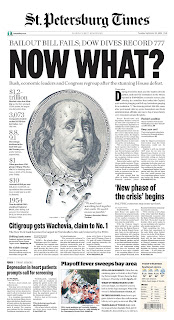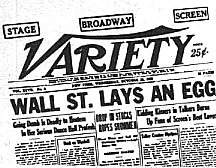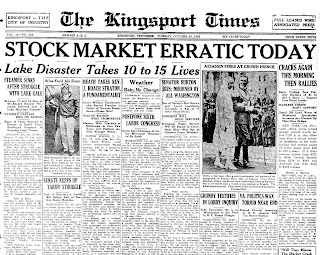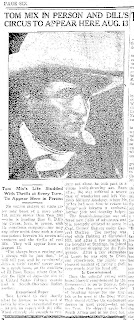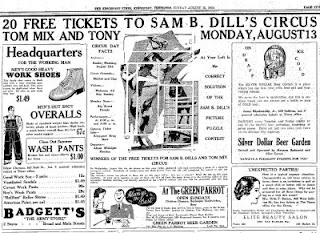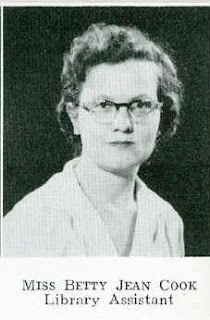Great Headlines I Have Seen
It’s probably the most famous headline in newspaper history. And it wasn’t even in a newspaper. It was the banner headline in the trade paper Variety, the so-called “bible of show business,” on the day the stock market crashed in 1929:
WALL ST. LAYS AN EGG
After Monday’s historic stock market plunge, I wondered how today’s headline writers would compare. Did anyone come up with such a memorable headline?
To find out I went to the website of the Newseum, the silly-named journalism museum in Washington D.C.
Every day the website (newseum.org) posts the front pages of 628 newspapers from 57 countries.
Did anyone come up with a “Wall St. Lays An Egg?”
No. But maybe that’s asking too much. That really was a once in a lifetime headline.
The most popular headline was: “Now What?” or its variation “What Now?” Among those using “Now What?” in Tuesday’s newspapers were the San Francisco Chronicle, Bakersfield Californian, Aurora (Colorado) Sentinel, Miami Herald and St. Petersburg Times, which gets extra points for an illustration of Ben Franklin sweating.
The Stamford Advocate, Indianapolis Star, Rocky Mountain News and Denver Post all went with “What Now?” That’s particularly interesting since the Rocky and the Post are competing newspapers in Denver.
The New York Times and The Wall Street Journal used standard non-cutesy headlines. The Times had “Defiant House Rejects Huge Bailout; Stocks Plummet; Next Step Uncertain.” The Wall Street Journal’s headline read: “Bailout Plan Rejected; Markets Plunge, Forcing New Scramble To Solve Crisis.”
Still there was a lot of creativity out there.
The Winston Salem Journal had “Deal And No Deal.”
Newsday wrote, “Well, That Didn’t Work.”
The New York Daily News’ headline was “Fools On The Hill.”
The Huntsville (Alabama) Times’ head read simply “Ouch!”
Other good ones:
San Jose Mercury News: “Where Do We Go From Here?”
Fort Lauderdale Sun Sentinel: “We’re In Trouble.”
Chicago Tribune “How Low Will It Go?”
Peoria (Illinois) Star: “Panic Monday” (playing off the Bangles’ hit song Manic Monday). The Lufkin Texas Daily News didn’t bother to play off the song. It just bannered “Manic Monday.”
Topeka Capitol Journal: “Failure To Launch”
Our neighbor The Johnson City Press had a unique headline: “Stockwaves.”
I think my favorite headline came from a paper I’d never heard of, the Log Cabin Democrat in Conway Arkansas which referenced Homer Simpson with this simple headline: “D’Oh!”
Among the intriguing foreign newspaper headlines – none of which I could read (except those in English) – was “Svart Mandag” in the Stockholm Aftonbladet. I ran the phrase through an online Swedish-to-English dictionary and it wasn’t so intriguing after all. It means “Black Monday.”
(Aftonbladet is Swedish for “The Evening Sheet.”)
If you’re wondering about Variety’s headline on Tuesday it was this:
“Wall St. Lays An Egg – The Sequel!”
Of course. They can’t beat their old headline either.
XXX
How did this newspaper do eighty years ago when the stock market crashed? Not too well. The headline in the Kingsport Times the afternoon of October 29, 1929 was “Stock Market Erratic Today.”
Given that the market hadn’t closed when the Times went to press that afternoon, I checked the paper for the next day, Oct. 30, 1929. It was still a little off: “Stock Selling Frenzy At End.”
XXX
I’ve been a fan of great headlines since I was a freshman in college and papered my dorm room wall with them.
Among my favorites:
“Ford to City: Drop Dead” – in the New York Daily News after President Gerald Ford nixed a bail out for financially troubled New York City in 1975.
The unintentionally funny “Rod Stewart Songs To Become Musical” from Edinburgh’s The Scotsman after the announcement that a producer was considering a musical revue based on Stewart’s hits.
And maybe the best headline of all time, from the British Sun, after the Inverness Caledonian Thistle soccer team upset Glasgow Celtic in the Scottish Cup in 2000: “Super Caley Go Ballistic. Celtic Are Atrocious.”
If you really like puns, you may prefer this legendary headline from the British journal Private Eye on a story about a book shortage in the library of the British town of Chipping Ongar, Essex: “Book Lack In Ongar.”


